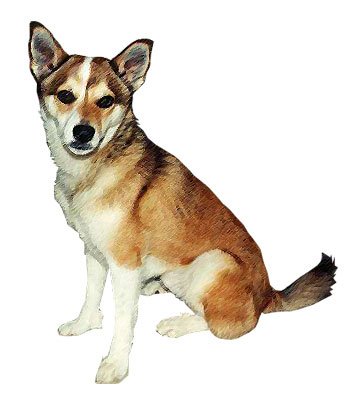
The Norwegian lundehund was developed during the 1500s in Norway to hunt the puffin birds that were among the dietary mainstays of the Norwegian people. When puffins were declared an endangered species during the early 1900s, the hunting services of the Norwegian lundehund were no longer permitted. The breed’s numbers had declined to near extinction by the end of World War II. The dog made its way to the United States in 1987. In 2011, the American Kennel Club recognized the rare Norwegian lundehund as a member of the non-sporting group.
The Norwegian Lundehund is a small Spitz-type breed, with a body slightly longer than tall. They have wedge-shaped heads with long pointy muzzles. Their ears are triangular and erect. The Lundehund is also polydactyl: They usually have six toes. Their double coats are soft and easy to care for. Brush and bathe as necessary.
Personality
The Lundehund is a loyal, smart and affectionate breed. They need plenty of exercise and need active owners that can give them lots of exercise on a daily basis. They also like to climb. They are friendly and affectionate. Lundehunds are eager to please and intelligent, and are easily trained.
Breed Characteristics
| Life Span: | 6-8 Years |
| Nicknames: | Norwegian puffin dog, Norsk lundehund, lundie, lundehund |
Norwegian Lundehund Build Information
The Norwegian lundehund is a spitz breed, which means that it displays pointed ears that stand erect and a plumed tail that curls up over the hindquarters. The breed also possesses some unusual traits, including six toes on each paw, ears that can close and fold in either direction, a double-jointed neck, forelimbs that can turn completely outward and extreme flexibility. All of these quirky characteristics are what enable the dog to carry out its original task of hunting puffin birds from small crevices and recesses of steep cliffs. The thick coat is short and rough, and it may be reddish brown, tan or fallow in color with white markings and black hair tips. A white coat with dark or red markings is another common color pattern. The Norwegian Lundehund is a small Spitz-type breed, with a body slightly longer than tall. They have wedge-shaped heads with long pointy muzzles. Their ears are triangular and erect. The Lundehund is also polydactyl: They usually have six toes. Their double coats are soft and easy to care for. Brush and bathe as necessary.
| Size: | Small |
Behaviour and Personality
The Norwegian lundehund is energetic and playful. It makes an outstanding competitor in agility coursing and other canine sports. The breed is intelligent and very curious. A Norwegian lundehund's flexibility and inquisitive nature can get the dog into trouble when venturing into tight spaces that are off-limits. The little Houdini can manage its way in and out of anything, so owners will need to be especially diligent in securing the dog's confines. These dogs also love to dig. When it comes to vocalizing, the Norwegian lundehund's repertoire includes barks, howls, screams and yodels. If raised with children, cats and other dogs, the Norwegian lundehund can get along with the entire family. Due to its extensive exercise needs, this breed is not an ideal apartment pet. The Lundehund is a loyal, smart and affectionate breed. They need plenty of exercise and need active owners that can give them lots of exercise on a daily basis. They also like to climb. They are friendly and affectionate. Lundehunds are eager to please and intelligent, and are easily trained.
| Activity Level: | Very Active |
| Affection Level: | Affectionate |
| Kid Friendliness: | Friendly |
Appearance
The Norwegian lundehund's thick coat requires daily brushing to remove the dead hair and reduce shedding in the home. The Norwegian Lundehund's teeth should also be brushed daily in order to remove plaque and prevent periodontal disease.
| Shedding: | Constant |
| Grooming: | High Maintenance |
Norwegian Lundehund Common Health Conditions
Norwegian lundehunds live average lifespans of 6 to 8 years. Intestinal disorders, known collectively in this breed as lundehund syndrome, are extremely prevalent in Norwegian lundehunds.
Norwegian Lundehund Pet Insurance
When adding a dog or cat to your family you want to make sure your pet is happy, healthy and protected. During its lifetime your pet is exposed to many illnesses and diseases and some breeds are affected by a congenital disease which is a condition existing at birth. At these moments when your pet is ill or maybe needs surgery, you want to be protected for the unexpected and high veterinarian costs.
Get a Free Pet Insurance Quote
Breed Talents and Facts
One of the most rare breeds in the world is the Norwegian lundehund. Originally bred for hunting seaside birds from cliffs, the curious nature of this breed and its propensity for squeezing in and out of tight spaces can provide a challenge for some owners. The Norwegian lundehund originated in Norway. The Norwegian lundehund is also called a Norwegian puffin dog, a Norsk lundehund, a lundie and a lundehund. The Norwegian lundehund is known for its curious nature, amazing agility and unusual physical characteristics. The Norwegian lundehund stands 12 to 15 inches tall and weighs 13 to 16 pounds. Norwegian lundehunds have high energy levels. Norwegian lundehunds require moderate grooming. The average lifespan for a Norwegian lundehund is 6 to 8 years.
| Training: | Easy |